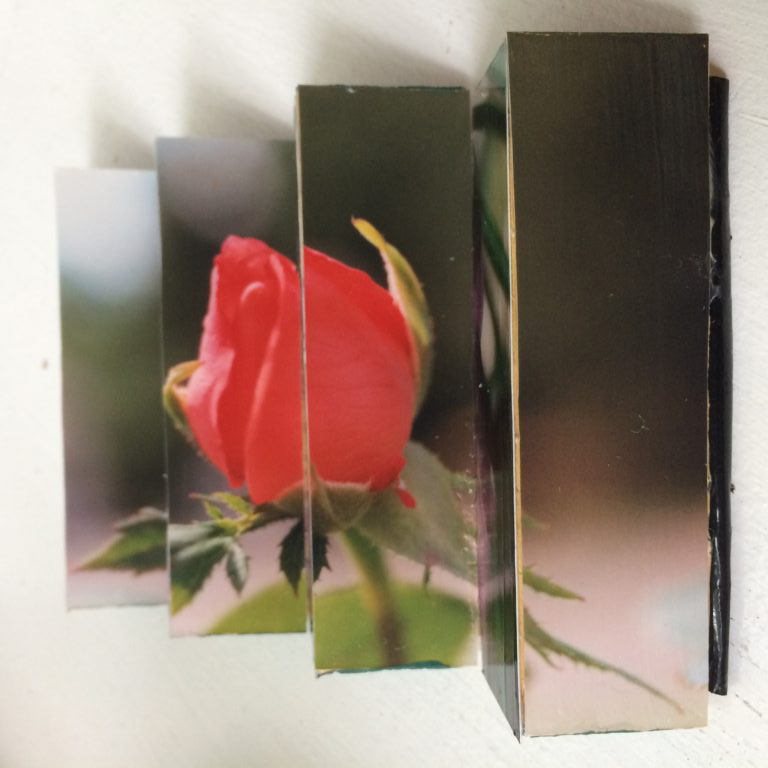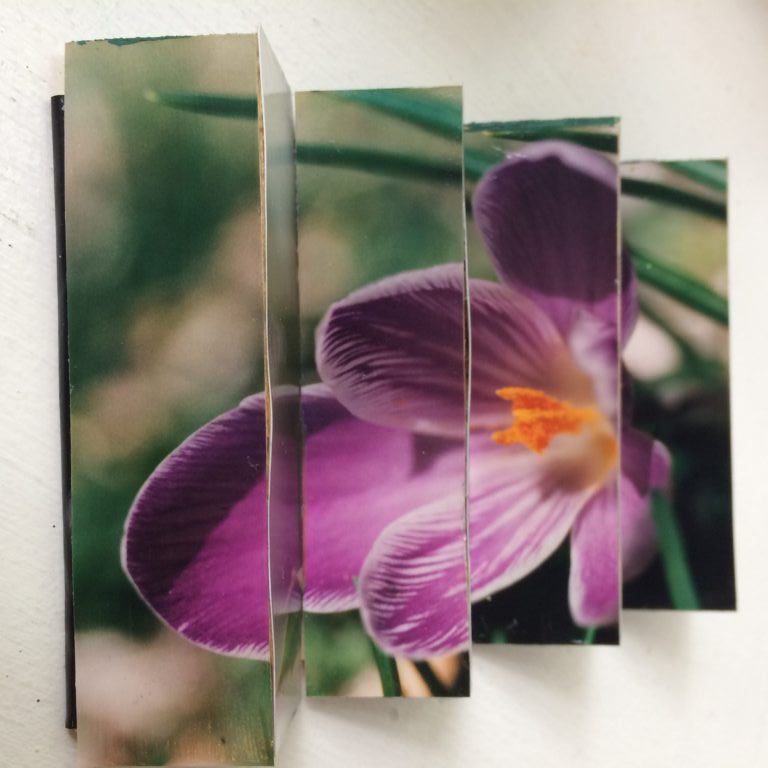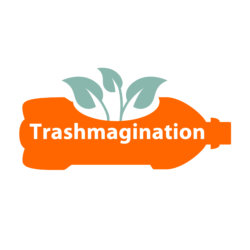Lenticular Photo Display
My Lenticular Photo Display / Business Card Holder from Clementine Boxes


Here’s my project – it’s called a Lenticular Photo Display / Business Card Holder. I had taken apart maybe 15 clementine boxes which provided wood in four shapes:
- large flat pieces on the bottom of the boxes,
- long skinny pieces along the sides,
- short pieces at the ends, and
- triangle pieces that hold the box together at the corners.
I wanted to find a fun project to use the triangle pieces. I had an idea to glue the triangle pieces to the flat side pieces and paint them in rainbow colors. My plan was to paint the words “family” or “creative reuse” on the triangles to make a wooden sign to display on the wall – and I might still do that project. But I was not sure how to put the letters on the
triangles, so I asked my husband for his thoughts. That’s when he told me about the concept of lenticular photos. Those are photos that are engineered so that when you look at them from one angle, they show one image, and when you change your angle, it shows a different image. Have you heard of that? It is a technique sometimes used in movie posters.
We talked about what types of photos might work in this project. To leverage the angle of the triangles, it made the most sense to use a photo that was more vertical than horizontal. I found magazine images as well as photos on photo paper. In terms of subject matter, it needed to be an image that made sense even if you could only see one slice at a time. It needed to be one big object rather than a busy photo or the human eye might not connect all the parts.
I started with the magazine images, but it didn’t work that well. The triangle pieces from the clementine boxes are not perfectly flat. They have bumps and gouges in them from where the staples held the box together. When I glued the magazine pages to the triangles, it did not cover all these imperfections.
Next I tried it with the printed photographs. The photos I chose showed big flowers which I thought would be a nice subject matter if I gave this craft to my grandmother for her monthly gift. She is a great gardener and loves flowers. This worked much better. The photo paper was thicker and covered the imperfections of the wood. On one side of the triangles, I put a rose photo and on the other side, I put a crocus photo. I then painted the ends of the triangles dark green and glued it to one of the end pieces of the clementine box to hold the triangles together.
Just to note – I used Mod Podge to glue the photos to the triangles. I also put a layer of Mod Podge over the photos to make the whole project nice and shiny!
This is such a great example of how Trashmagination works! I save the materials until I have enough to do something interesting. I play with the materials. I propose an idea to my husband. He brings in an idea that is totally not related and much more mind–bending. I then try to implement the idea. It fails. I try another method, and it works.
I can see many uses for this project. I could make personalized gifts by taking photos of family and friends and putting it in this format. I could put a photo of a beloved family recipe on one side and then a photo of the food on the other side. Or it could be a baby photo on one side and the birth announcement on the other. Or wedding photo and invitation! Can you think of other ways to have fun with this design?
It’s also a great business card holder! You can put your business cards at one end – maybe over a part of the photo that is not essential to view, or you could add an extra triangle just to hold the business cards.
Trashmagination, US

PROFILE
Carla Brown hosts Trashmagination, a podcast about reimagining trash and the creative reuse of recycled materials.
A lot of the content focuses on what artists have made from recycled materials. I share their stories so widen our perspectives on what is possible. But I also share ideas for smaller projects many people can do without having any background in art.
I came up with the term “trashmagination” when I heard the quote “Trash is the failure of imagination,” from Aaron Kramer from Urban Objects. It summarizes my belief that we can solve a lot of challenges with imagination.
Main Research Source
- Clementine Boxes(07/2018)
